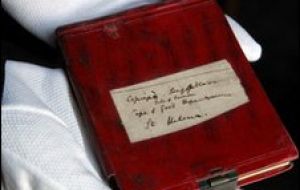MercoPress. South Atlantic News Agency
On the 150th anniversary of “On the origin of species”, Darwin’s missing notebook
 One of the 15 field notebooks from the great botanist
One of the 15 field notebooks from the great botanist Charles Darwin's encounter with the first of the two creatures that would provide him with the early clues for his theory of evolution was not a dramatic one. “Met an immense Turpin; took little notice of me,” the 26-year-old jotted in his notebook in 1835.
But the young naturalist would take notice of the tortoise, not least when he later heard it remarked that the tortoises on different Galapagos Islands could be distinguished from each other by the variations in their shells.
Working his way across the Galapagos archipelago, Darwin continued to scribble down notes: “The Thenca very tame & curious in these Islds. I certainly recognise S. America in ornithology, would a botanist?”
Thenca was the Spanish name for the Chilean mockingbird. Darwin noted the similarity between the mainland bird and those on the Galagapos, but he also noticed the differences between his specimens from different islands.
Years later in On the Origin of Species, Darwin would answer that hastily-jotted question with his theory that species were not fixed for all time but were continuously evolving:
“The relations just discussed … [including] the very close relation of the distinct species which inhabit the islets of the same archipelago, and especially the striking relation of the inhabitants of each whole archipelago or island to those of the nearest mainland, are, I think, utterly inexplicable on the ordinary view of the independent creation of each species, but are explicable on the view of colonisation from the nearest and readiest source, together with the subsequent modification and better adaptation of the colonists to their new homes.”
Darwin's Galapagos notebook is an invaluable record of some of the most famous few weeks in the history of science. It is also missing and on this, the 150th anniversary of the publication of On the Origin of Species, we are asking the public for its help in finding it.
The notebook disappeared - it was possibly stolen - around the early 1980s from the home of Charles Darwin, Down House in Kent, before the house came under the care of English Heritage.
The missing notebook is small, almost square, and bound in red leather with a brass clasp. It is labelled on the outside with a rough itinerary in Darwin's handwriting, marked “Galapagos. Otaheite. Lima”. Inside the front cover is written, “C. Darwin H.M Beagle”.
The first alarm bells as to its whereabouts sounded in the early 1980s when Professor Richard Keynes, great grandson of Charles Darwin, visited Down House and noticed it was missing.
There was a period when the notebooks had been kept on one of the tables in Darwin's study, within easy reach of visitors. When English Heritage acquired Down House in 1996, we registered the notebook with The Art Loss Register.
Thankfully a microfilm of the Galapagos notebook was made in 1969. And our appeal for help comes as we publish online highlights from the microfilm and the full contents of the remaining 14 notebooks that Darwin used to jot down his day-to-day thoughts while travelling around the world on board HMS Beagle.
Visitors to www.english-heritage.org.uk/darwin will be able to read the notebooks - all 116,000 words and 300 sketches and doodles - for themselves.
They offer special glimpses into Darwin's mind: while out in the field, the scientist would scribble down his immediate - and often brilliant - thoughts on what most intrigued him.
They contain a mixture of geological, zoological and personal observations, including notes on the fossils he had excavated, his discovery of a new frog off Chile, and an attack by giant black bedbugs in Argentina.
Down House in Kent was home to Charles Darwin for 40 years. The ground floor rooms have been re-created as they appeared when he lived there with his wife and their ten children.
They include the study where Darwin wrote his books - it still displays his chair, desk and many personal items. But the missing Galapagos notebook remains a serious loss and while it is wonderful that people can now leaf through his notebooks online, we're hoping that the missing notebook will be returned to the home of its writer.
By Annie Kemkaran-Smith, English Heritage curator at the Home of Charles Darwin, Down House in Kent




Top Comments
Disclaimer & comment rulesCommenting for this story is now closed.
If you have a Facebook account, become a fan and comment on our Facebook Page!